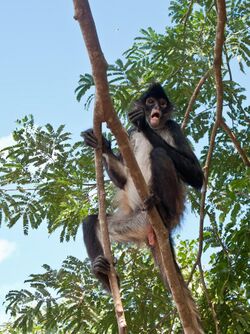Biology:Yucatan spider monkey
| Yucatan spider monkey[1] | |
|---|---|

| |
| Scientific classification | |
| Domain: | Eukaryota |
| Kingdom: | Animalia |
| Phylum: | Chordata |
| Class: | Mammalia |
| Order: | Primates |
| Suborder: | Haplorhini |
| Infraorder: | Simiiformes |
| Family: | Atelidae |
| Genus: | Ateles |
| Species: | |
| Subspecies: | A. g. yucatanensis
|
| Trinomial name | |
| Ateles geoffroyi yucatanensis (Kellogg & Goldman, 1944)
| |
The Yucatan spider monkey (Ateles geoffroyi yucatanensis) is a subspecies of Geoffroy's spider monkey, and is one of the largest types of New World monkey. It inhabits Mexico, Guatemala and Belize.[3][2] It is a social animal, living in groups of 20-42 members.[4]
Description
The Yucatan spider monkey weighs around 9 kg, making it one of the largest of the New World monkeys.[1] It has long arms and a prehensile tail, which can support its own weight.[5] The body is long and slender and covered with black hair, which is coarse and often looks matted. The fur is somewhat paler than that of the Mexican spider monkey.[3] There are usually tan-coloured markings around the eyes and chin, and whiskers around the head area.[4]
Ecology
Social groups
The Yucatan spider monkey is very social, living in groups of anywhere between 10 and 100 members (20-42 members on average). These groups are typically dominated by females, one of whom plans foraging routes for the rest of the group.[4]
Male-male relationship have also been documented. In these there is a focus on physical behaviour such as grooming, embracing, arm-wrapping, and grappling. Though most of these actions are reciprocated between the two males, the most successful bonds tend to be between males of similar ages, with pronounced differences in male-male relationships with a larger age gap (between individuals of <10 years and ≥ 14 years). Actions performed between males of similar ages showed that the affection was beneficial for both of the monkeys, while in the relationships with larger age differences, a lot more affection was given by the younger male than was received, possibly showing the value of respect of elders in groups.[6]
Reproduction and lifespan
Yucatan spider monkeys reach an average age of 25 years in wild, while in captivity this is closer to 35 years. A female Yucatan spider monkey will produce a baby once every few years. The infant monkey is completely black, and will cling to its mother’s back for the first two years of its life. It will also only start eating fruit at around two years old.[citation needed]
Diet
The Yucatan monkey is frugivorous, with a diet consisting of around 90% fruit and 10% eggs and insects. In captivity, the Yucatan spider monkey’s diet generally consists of fruits, dog food, bread and a few vegetables, such as carrots and lettuce.[4]
The Yucatan spider monkey moves in straight lines towards its food, and is able to orient its movement to foraging areas invisible from its current vantage point. Individuals consistently plan out foraging areas ahead of time.[7]
Foraging behaviour after a natural disaster (a hurricane) showed increased splitting up into smaller sub-groups. Less time was spent moving, and the main food source changed from fruit to leaves.[8]
Conservation
The Yucatan spider monkey is classified as Endangered by the IUCN due to ongoing rapid population decline (totalling well over 5-% over three generations) caused by continued habitat loss.[2]
References
- ↑ 1.0 1.1 Groves, C.P. (2005). Wilson, D.E.; Reeder, D.M.. eds. Mammal Species of the World: A Taxonomic and Geographic Reference (3rd ed.). Baltimore: Johns Hopkins University Press. ISBN 0-801-88221-4. OCLC 62265494. http://www.departments.bucknell.edu/biology/resources/msw3/browse.asp?id=12100404.
- ↑ 2.0 2.1 2.2 Cuarón, A.D.; Morales, A.; Shedden, A.; Rodriguez-Luna, E.; de Grammont, P.C. (2008). "Ateles geoffroyi ssp. yucatanensis". IUCN Red List of Threatened Species 2008. https://www.iucnredlist.org/details/2290/0. Retrieved 19 January 2011.
- ↑ 3.0 3.1 Rylands, A.; Groves, C.; Mittermeier, R.; Cortes-Ortiz, L.; Hines, J. (2006). "Taxonomy and Distributions of Mesoamerican Primates". New Perspectives in the Study of Mesoamerican Primates. pp. 56–66. ISBN 978-0-387-25854-6.
- ↑ 4.0 4.1 4.2 4.3 "Spider Monkeys". http://www.beautiful-yucatan-peninsula.com/spider-monkeys.html.
- ↑ "Mono araña - Crococun Zoo" (in es-ES). Crococun Zoo. http://crococunzoo.com/es/portfolios/mono-arana/.
- ↑ Schaffner, Colleen M.; Slater, Kathy Y.; Aureli, Filippo (2012-01-01). "Age related variation in male–male relationships in wild spider monkeys (Ateles geoffroyi yucatanensis)" (in en). Primates 53 (1): 49–56. doi:10.1007/s10329-011-0271-5. ISSN 0032-8332. PMID 21881958.
- ↑ Spider monkey (Ateles geoffroyi yucatanensis) travel patterns in a subtropical forest of Yucatan, Mexico (Thesis). University of St Andrews. 2004-01-01.
- ↑ Schaffner, Colleen M.; Rebecchini, Luisa; Ramos-Fernandez, Gabriel; Vick, Laura G.; Aureli, Filippo (2012-08-01). "Spider Monkeys (Ateles geoffroyi yucatenensis) Cope with the Negative Consequences of Hurricanes Through Changes in Diet, Activity Budget, and Fission–Fusion Dynamics" (in en). International Journal of Primatology 33 (4): 922–936. doi:10.1007/s10764-012-9621-4. ISSN 0164-0291.
Wikidata ☰ Q5481599 entry


